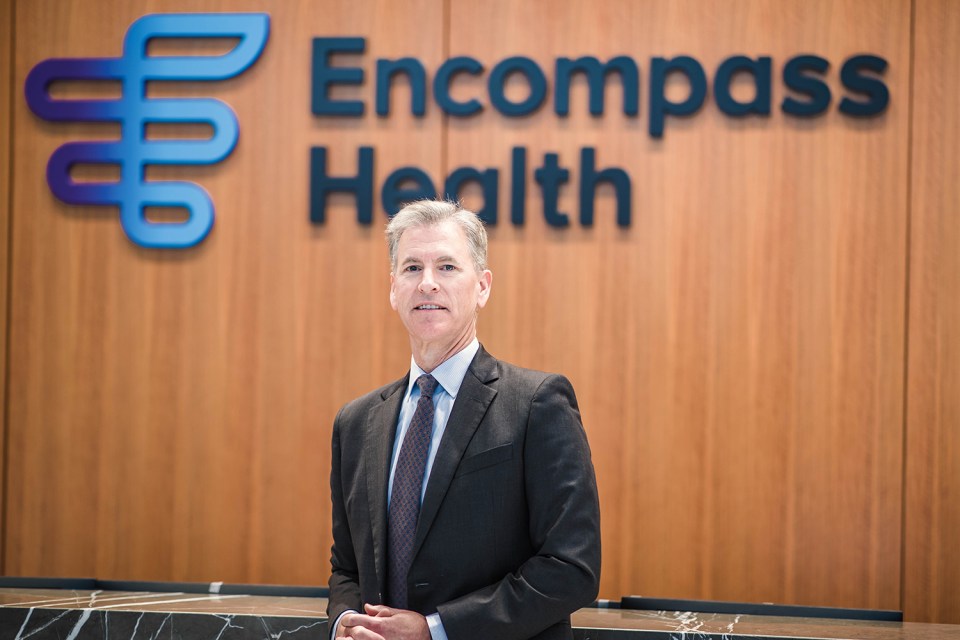Recently, we released our earnings report for Q4 2019 and hosted our quarterly earnings call. We’re pleased to report the final quarter of 2019 was a strong one for Encompass Health, as was 2019 as a whole.
While you may find the full results of the fourth quarter and 2019 at investor.encompasshealth.com, I thought we could use this space to address some of the more frequently asked questions, as well as some of our priorities for 2020.
We are responding well to the two regulatory changes facing our inpatient rehabilitation hospitals and home health locations
For more than a year, we’ve been preparing for regulatory changes impacting Medicare reimbursement in each of our business segments. Our inpatient rehabilitation hospitals transitioned to the CMS Section GG for reporting and payment purposes on Oct. 1, 2019. We were well prepared for this transition, and it’s going as well as we anticipated.
With the Patient Driven Groupings Model (PDGM) impacting our home health locations, it’s still early; it didn’t go into effect until Jan. 1. Operationally, we’ll continue to use technology to generate objective, evidence-based care plans and drive incremental efficiencies in administrative support functions. This includes our deployment of the Medalogix Care module across our entire portfolio of home health locations in the first half of this year. This tool will help us develop the just right care plan for each patient. We are also working with Homecare Homebase on a scheduling module that will give us a new set of tools to further manage staff productivity and optimization.
2020 could present several growth opportunities for the Company
With nine hospitals under development, four of which are slated to open this year, we’ve already gotten off to a good start in the area of growth. And, there are a couple of factors that could present even more opportunities for us in both business segments.
First, in home health, we have PDGM. We believe there will likely be disruption among some of the smaller scale providers due to the implementation of PDGM. Our folks on the ground are paying close attention, and if there are agencies that are struggling, we’ll be ready to make inquiries.
Then, in inpatient rehabilitation, we have the repeal of Florida’s CON laws. With 12 hospitals currently there, we have a strong presence in the state. We see the CON repeal as a good opportunity to increase our presence even more. What we’re trying to determine now is when we can do that. The repeal for new hospitals goes into effect in July 2021, but it’s unclear if that means we can open the doors or we can break ground at that time. In the meantime, we’re actively viewing land in Florida and looking at how we can expand in existing hospitals.
We will continue to build our stroke market share, as more see the value in inpatient rehabilitation for these complex patients
We believe inpatient rehabilitation is a better setting to treat stroke patients, and there is research and studies to support that. Independent third parties such as the American Heart Association/American Stroke Association (AHA/ASA), the Veterans’ Administration and a recent study released in the Journal of American Medical Association all conclude that inpatient rehabilitation is a superior setting for stroke patients due to the intensity of therapy provided.
With 123 of our hospitals holding stroke-specific disease certification from The Joint Commission, we believe we are well positioned to serve this patient population. Our three-year stroke CAGR for all stroke patients is approximately 6 percent, and our three-year stroke CAGR for Medicare Advantage Plans is approximately 13 percent.
This year, we’ll continue to educate physicians, payors and patients on the value of inpatient rehabilitation for stroke patients. One way we’re doing that is through our strategic sponsorship of the AHA/ASA’s Together to End Stroke initiative. Last year was the first year of this three-year sponsorship. We believe the sponsorship increased awareness of Encompass Health and our expertise in treating stroke patients. We’ll continue to leverage this sponsorship in 2020.
By leveraging our early investments in IT, we’ll continue to develop post-acute solutions that don’t exist in the marketplace today
Encompass Health was an early adopter of an electronic health record (EHR) in the post-acute space. That investment is paying off and allowing us to create post-acute solutions to improve outcomes throughout the entire episode of care.
In 2020, we’ll continue our work with Cerner, a leader in health information technology, to develop those solutions. Our development work will focus on reducing readmissions to reduce the episodic cost of care. We expanded our proprietary readmission prediction model to nine hospitals last year, and this year, we will roll it out companywide. The model will predict the risk of a patient readmitting to an acute hospital after they are discharged from an Encompass Health hospital. A playbook with best practices will also be a part of this rollout.
As mentioned earlier, we’ll also be using Medalogix’s Care module in our home health locations. Using historical patient data, this module tells us how many visits a patient needs and when they need them to optimize the outcome for the patient. It’s a scientific approach that helps guide—not replace—clinical judgement.
As you can see, 2020 will be another busy and exciting year for Encompass Health. Stay tuned as we’ll be revealing more at our upcoming investor day in New York City on March 4.
Forward-Looking Statements
Statements contained in this blog post which are not historical facts, such as those relating to the likelihood, timing and effects of growth opportunities, building stroke market share, and the development of post-acute solutions, are forward-looking statements. In addition, Encompass Health may from time to time make forward-looking public statements concerning the matters described herein. All such estimates, projections, and forward-looking information speak only as of the date hereof, and Encompass Health undertakes no duty to publicly update or revise such forward-looking information, whether as a result of new information, future events, or otherwise. Such forward-looking statements are necessarily estimates based upon current information and involve a number of risks and uncertainties. Encompass Health’s actual results or events may differ materially from those anticipated in these forward-looking statements as a result of a variety of factors. While it is impossible to identify all such factors, factors which could cause actual results or events to differ materially from those anticipated include, but are not limited to, the regulatory review and approval process, any adverse outcome of various lawsuits, claims, and legal or regulatory proceedings that may be brought by or against the Company; the possibility this development projects will experience unexpected delays; the ability to identify acquisition targets that are consistent with Encompass Health’s growth strategy, changes in the regulation of the healthcare industry at either or both of the federal and state levels; competitive pressures in the healthcare industry and Encompass Health’s response thereto; potential disruptions, breaches, or other incidents affecting the proper operation, availability, or security of Encompass Health’s information systems or the systems of its vendors such as Medalogix; changes, delays in (including in connection with resolution of Medicare payment reviews or appeals), or suspension of reimbursement for Encompass Health’s services by governmental or private payors; general conditions in the economy and capital markets; and other factors which may be identified from time to time in Encompass Health’s SEC filings and other public announcements, including Encompass Health’s Form 10-K for the year ended December 31, 2018 and Form 10-Q for the quarters ended Sept. 30, 2019, June 30, 2019 and March 31, 2019.
The content of this site is for informational purposes only and should not be taken as professional medical advice. Always seek the advice of your physician or other qualified healthcare provider with any questions you may have regarding any medical conditions or treatments.



